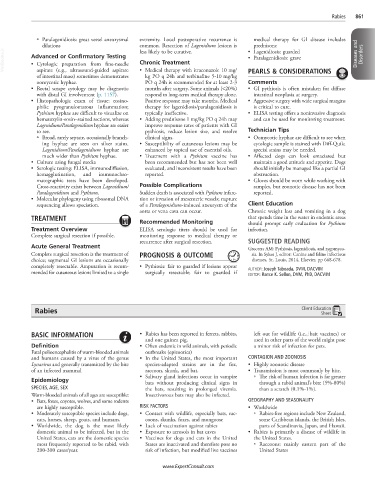Page 1710 - Cote clinical veterinary advisor dogs and cats 4th
P. 1710
Rabies 861
○ Paralagenidiosis: great vessel aneurysmal extremity. Local postoperative recurrence is medical therapy for GI disease includes
prednisone
dilations common. Resection of Lagenidium lesions is • Lagenidiosis: guarded
VetBooks.ir Advanced or Confirmatory Testing Chronic Treatment • Paralagenidiosis: grave Diseases and Diseases and Disorders Disorders
less likely to be curative.
• Cytologic preparation from fine-needle
aspirate (e.g., ultrasound-guided aspirate
of intestinal mass) sometimes demonstrates • Medical therapy with itraconazole 10 mg/ PEARLS & CONSIDERATIONS
kg PO q 24h and terbinafine 5-10 mg/kg
oomycotic hyphae. PO q 24h is recommended for at least 2-3 Comments
• Rectal scrape cytology may be diagnostic months after surgery. Some animals (<20%) • GI pythiosis is often mistaken for diffuse
with distal GI involvement (p. 1157). respond to long-term medical therapy alone. intestinal neoplasia at surgery.
• Histopathologic exam of tissue: eosino- Positive response may take months. Medical • Aggressive surgery with wide surgical margins
philic pyogranulomatous inflammation; therapy for lagenidiosis/paralagenidiosis is is critical to cure.
Pythium hyphae are difficult to visualize on typically ineffective. • ELISA testing offers a noninvasive diagnosis
hematoxylin-eosin–stained sections, whereas • Adding prednisone 1 mg/kg PO q 24h may and can be used for monitoring treatment.
Lagenidium/Paralagenidium hyphae are easier improve response rates of patients with GI
to see. pythiosis, reduce lesion size, and resolve Technician Tips
○ Broad, rarely septate, occasionally branch- clinical signs. • Oomycotic hyphae are difficult to see when
ing hyphae are seen on silver stains. • Susceptibility of cutaneous lesions may be cytologic sample is stained with Diff-Quik;
Lagenidium/Paralagenidium hyphae are enhanced by topical use of essential oils. special stains may be needed.
much wider than Pythium hyphae. • Treatment with a Pythium vaccine has • Affected dogs can look emaciated but
• Culture using fungal media been recommended but has not been well maintain a good attitude and appetite. Dogs
• Serologic testing: ELISA, immunodiffusion, evaluated, and inconsistent results have been should initially be managed like a partial GI
hemagglutination, and immunochro- reported. obstruction.
matographic tests have been developed. • Gloves should be worn while working with
Cross-reactivity exists between Lagenidium/ Possible Complications samples, but zoonotic disease has not been
Paralagenidium and Pythium. Sudden death is associated with Pythium infarc- reported.
• Molecular phylogeny using ribosomal DNA tion or invasion of mesenteric vessels; rupture
sequencing allows speciation. of a Paralagenidium-induced aneurysm of the Client Education
aorta or vena cava can occur. Chronic weight loss and vomiting in a dog
TREATMENT that spends time in the water in endemic areas
Recommended Monitoring should prompt early evaluation for Pythium
Treatment Overview ELISA serologic titers should be used for infection.
Complete surgical resection if possible. monitoring response to medical therapy or
recurrence after surgical resection. SUGGESTED READING
Acute General Treatment Grooters AM: Pythiosis, lagenidiosis, and zygomyco-
Complete surgical resection is the treatment of PROGNOSIS & OUTCOME sis. In Sykes J, editor: Canine and feline infectious
choice; segmental GI lesions are occasionally diseases, St. Louis, 2014, Elsevier, pp 668-678.
completely resectable. Amputation is recom- • Pythiosis: fair to guarded if lesions appear AUTHOR: Joseph Taboada, DVM, DACVIM
mended for cutaneous lesions limited to a single surgically resectable; fair to guarded if EDITOR: Rance K. Sellon, DVM, PhD, DACVIM
Rabies Client Education
Sheet
BASIC INFORMATION • Rabies has been reported in ferrets, rabbits, left out for wildlife (i.e., bait vaccines) or
and one guinea pig. used in other parts of the world might pose
Definition • Often endemic in wild animals, with periodic a minor risk of infection for pets.
Fatal polioencephalitis of warm-blooded animals outbreaks (epizootics)
and humans caused by a virus of the genus • In the United States, the most important CONTAGION AND ZOONOSIS
Lyssavirus and generally transmitted by the bite species-adapted strains are in the fox, • Highly zoonotic disease
of an infected mammal raccoon, skunk, and bat. • Transmission is most commonly by bite.
• Salivary gland infections occur in vampire ○ The risk of human infection is far greater
Epidemiology bats without producing clinical signs in through a rabid animal’s bite (5%-80%)
SPECIES, AGE, SEX the bats, resulting in prolonged viremia. than a scratch (0.1%-1%).
Warm-blooded animals of all ages are susceptible: Insectivorous bats may also be infected.
• Bats, foxes, coyotes, wolves, and some rodents GEOGRAPHY AND SEASONALITY
are highly susceptible. RISK FACTORS • Worldwide
• Moderately susceptible species include dogs, • Contact with wildlife, especially bats, rac- ○ Rabies-free regions include New Zealand,
cats, horses, sheep, goats, and humans. coons, skunks, foxes, and mongoose some Caribbean islands, the British Isles,
• Worldwide, the dog is the most likely • Lack of vaccination against rabies parts of Scandinavia, Japan, and Hawaii.
domestic animal to be infected, but in the • Exposure to aerosols in bat caves • Rabies is primarily a disease of wildlife in
United States, cats are the domestic species • Vaccines for dogs and cats in the United the United States.
most frequently reported to be rabid, with States are inactivated and therefore pose no ○ Raccoons: mainly eastern part of the
200-300 cases/year. risk of infection, but modified live vaccines United States
www .ExpertConsult.com
www.ExpertConsult.com

